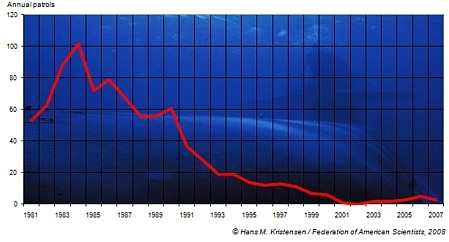Russian Nuclear Missile Submarine Patrols Decrease Again

By Hans M. Kristensen
The number of deterrence patrols conducted by Russia’s 11 nuclear-powered ballistic missiles submarines (SSBNs) decreased to only three in 2007 from five in 2006, according to our latest Nuclear Notebook published in the Bulletin of the Atomic Scientists.
In comparison, U.S. SSBNs conducted 54 patrols in 2007, more than three times as many as all the other nuclear weapon states combined.
The low Russian patrol number continues the sharp decline from the Cold War; no patrols at all were conducted in 2002 (see Figure 1). The new practice indicates that Russia no longer maintains a continuous SSBN patrol posture like that of the United States, Britain, and France, but instead has shifted to a new posture where it occasionally deploys an SSBN for training purposes.
An Occasional Sea-Based Deterrent
The shift to an occasional sea-based deterrent became apparent in 2007, when then Defense Minister Sergei Ivanov declared on September 11 that five SSBNs were on patrol at that time. Four months later, I received information from U.S. Naval Intelligence showing that those five patrols were all Russian SSBNs did that year. Combined, the two sources indicated a cluster of patrols at approximately the same time rather than distributed throughout the year.
|
Figure 1: |
 |
| Russian SSBNs conducted only three deterrent patrols in 2007, a decline from five in 2006. |
.
The reason for the shift is unclear. Perhaps the Russian navy is still not over the financial and technical constraints that hit it after the collapse of the Soviet Union. SSBNs can launch their missile from pier side if necessary, although such a posture essentially converts each SSBN into a very soft and vulnerable target. Russia might simply have decided that it’s no longer necessary to maintain a continuous nuclear retaliatory force at sea, and that a few training patrols are all that’s needed to be able to deploy the SSBNs in a hypothetical crisis if necessary.
SSBN Patrol Areas
Little is known in public about where Russian SSBNs conduct their deterrent patrols. However, in 2000, U.S. Naval Intelligence released a series of rough patrol maps for Soviet/Russian SSBNs that showed the locations of the patrol areas used by Delta IV and Typhoon class SSBNs in the late-1980s and 1990s (see Figure 2). The few SSBNs that occasionally sail on patrol today probably use roughly the same areas.
|
Figure 2: |
 |
| Russian SSBN patrol areas today are probably similar to those used in the 1990s. |
.
In Perspective
The decline in SSBN patrols is in stark contrast to Russian bomber and surface fleet operations in 2006-2007, which are said to have increased in scope and reach. For now, at least, SSBN patrols are not used to “signal” Russian status.
Approximately 20 percent of Russia’s strategic warheads are sea-based. But with the upcoming replacement of old Delta III SSBNs and their three-warhead missiles with the new Borey SSBNs (the first of which is scheduled to enter service later this year) with six-warhead missiles, the SSBNs’ share of the posture might increase to approximately 30 percent by 2015.
Overall, the Nuclear Notebook estimates that Russia currently has approximately 5,200 nuclear warheads in its operational stockpile, including some 3,110 strategic and 2,090 non-strategic warheads. Another 8,800 warheads are thought to be in reserve or awaiting dismantlement.
Additional information: Russian Nuclear Forces 2007, Nuclear Notebook, Bulletin of the Atomic Scientists
This report outlines a framework relying on “Cooperative Technical Means” for effective arms control verification based on remote sensing, avoiding on-site inspections but maintaining a level of transparency that allows for immediate detection of changes in nuclear posture or a significant build-up above agreed limits.
The grant comes from the Carnegie Corporation of New York (CCNY) to investigate, alongside The British American Security Information Council (BASIC), the associated impact on nuclear stability.
Satellite imagery of RAF Lakenheath reveals new construction of a security perimeter around ten protective aircraft shelters in the designated nuclear area, the latest measure in a series of upgrades as the base prepares for the ability to store U.S. nuclear weapons.
It will take consistent leadership and action to navigate the complex dangers in the region and to avoid what many analysts considered to be an increasingly possible outcome, a nuclear conflict in East Asia.